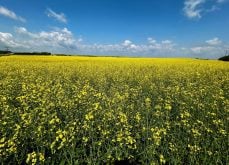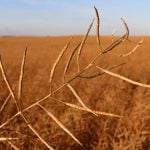A lone musk ox recently attracted the attention of five caribou hunters near Nejanilini Lake in northern Manitoba, but that was just the beginning of the “lonely” musk ox’s popularity.
The extremely rare treat prompted people to ask why musk ox have returned since their last sighting in the early 1800s.
Bill Watkins of Manitoba Conservation speculates that it is population pressure.
“The herd north of the border has quadrupled since 1985,” he said.
“With that increase in numbers, it’s natural for herds to spread out to accommodate all those animals.”
Read Also

Louis Dreyfus posts higher volumes, lower profits in first half
Agricultural commodity merchant Louis Dreyfus Company recorded a rise in first-half sales, supported by higher volumes shipped, but weaker prices for most crops pushed down profits, it said on Friday.
Watkins said the species is also expanding northwest and west, but Manitoba just happens to be a happy accident.
Watkins said predation pressure is likely another reason the animals are moving. The Nunavut government has noticed that the increase in musk ox has caused an increase in wolves and grizzly bears.
“If you’ve got predation pressure in one part of your range, it makes good sense to up and move into another range.”
Watkins emphasized that without a proper survey, this is just speculation. However, it is a good indication of what could be going on north of the border.
Watkins confirmed that this could the beginning of the mighty return of the musk ox, so long as proper conditions for the herd hold. Two severe winters in a row could knock back the herds, giving the remaining animals less reason to travel far from Nunavut.
“That’s the way nature works.”
Musk ox isn’t the only species making a comeback in Manitoba. Watkins said grizzly bears, cougars, pronghorn and trumpeter swans have also crossed the borders. Most sightings have been of juvenile males, but the breeding sites that bumped trumpeter swans from extirpated to endangered could also be happening with other species. Watkins especially hopes this is true for musk ox.
“It’s very likely what we’ll see over the next few years is groups of one or two animals, and it will probably still be some length of time before we see a breeding group,” he said.
“But I firmly believe we will see a breeding population.”
Watkins said it would take more than one year of breeding before musk ox would be considered a permanent resident.
“We’ll be watching very carefully to determine when it might be appropriate to lift them up to endangered.”
If the musk ox do return for good, they won’t go much further than the tree line. However, it would give ecotourism something else on which to focus.
Watkins said Churchill’s animal tourism would particularly benefit, placing the musk ox alongside polar bears and beluga whales.
He also that if the musk ox population ever grew large enough, the species could once again be seen as a food source.
Watkins said he isn’t aware of anything in Manitoba’s habitat that would prevent them from rejoining the ecosystem.














